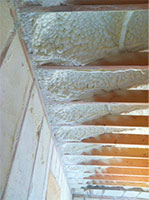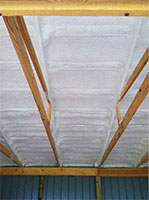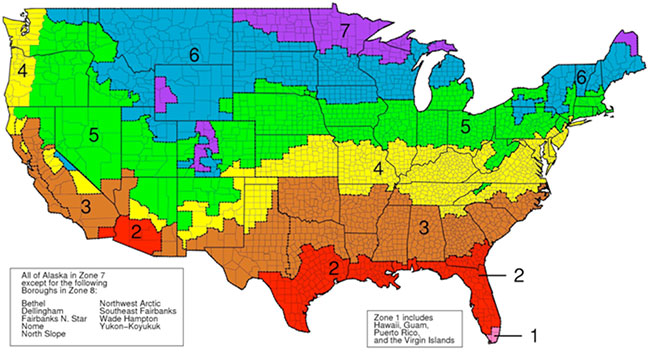Contact us:
Testimonials:
We love the spray foam you did for our home. Added 900 square ft, you put 6" foam in our roof 3 years ago over the upstairs addition. Our energy bills didn't go up a penny- just shows how much heat we were losing in the winter and letting in the attic in the summer. Great investment!
- Ernie, Jackson TNI have seen the Spray Foam system before, but only in the home improvement shows on TV. I was introduced to Apex by my contractor, and was convinced to try it. Couldn't be happier! Great return on investment.
- Mike, Nashville TNI was in my house built in 1948 for 3 winters, each year I would add more fiberglass insulation to the floors in my crawl space. My home was never warm until I tried spray foam. Not only is the house warmer, but it has saved me money on the energy bill.
- Michael, Nashville TNApex Building Company provided whole house residential spray foam insulation for my new home. They did an excellent professional job. I would recommend them for any insulation job of any size!
- George, Jackson TNI hired this company to spray insulation into my newly built steel construction home. They came in and did a very professional job enclosing the entire shell with open cell foam, sealing every conceivable leak. I have been very please with the results and ascribe my low utility bills to it!
- Pete, Memphis TNApex was very professional and knew about the product they were selling. I talked to several spray foam contractors and none of them were as knowledgeable as Michael at Apex. They cleaned up well and made sure things were done to suit me. I Highly Recommend them for anything spray foam or insulation!
- Jarrin, Memphis TN
Spray Foam Insulation Services
Save Money
New Standard Of Protection
Clean Air And Healthy Living
Understanding Building Science
OPEN CELL AND CLOSED CELL - CHOOSING THE RIGHT SYSTEM
Open cell and closed cell spray foam insulation for the home are both effective solutions — one or the other may work better in different climates and parts of the home.
Both spray foam types:
- Spray in as a liquid and expand to fill all gaps and holes
- Form an air barrier to stop drafts and air leakage
- Don't provide a food source for mold (check with your spray foam manufacturer)
- Don't provide a food source for pests
- Maintain form and thickness without the need to add insulation over time
- Can be applied to irregular surfaces to create a perfect thermal boundary
- Significantly reduce size and increase lifespan on heating & cooling
Here are some differences:
 OPEN CELL:
OPEN CELL:
- "Breathes" — it is vapor permeable and this can let your home dry out.
- Moderate cost $$ per square foot versus fiberglass
- Reduces sound transmission for privacy
- Flexible – moves with your house to ensure there are no gaps in your insulation and no loss of air seal
- Doesn’t absorb water; lets it drain down through the insulation (check with your spray foam manufacturer)
- Good thermal insulation - R-3.7 per inch thickness
- 3 inch minimum thickness is needed to get an air barrier
- Half-pound density is much softer than closed cell
- Water-blown application doesn’t required blowing agent.
 CLOSED CELL:
CLOSED CELL:
- Doesn’t “Breathe” – acts as a vapor retarder
- Higher cost $$$ per square foot in most applications Excellent air & vapor barrier for use in exterior cavities
- Great for use on crawlspace walls to eliminate moisture
- Perfect for insulating heated concrete floor on metal deck
- Stays rigid – helps wall strength; impact resistant
- Doesn’t let water in (check with your spray foam manufacturer) – this is an advantage in flood zones
- Great for flood prone areas Best option for metal buildings to conform to building structure and add structural strength
- Great thermal insulation – R-6.8 per inch thickness
Which climate zone are you located? Check the map at the bottom of the page.
COLD CLIMATES - ZONES 5 THRU 8 AND MARINE 4
ROOF, ATTIC, EXTERIOR WALLS, BONUS ROOMS:
-
Open cell (+vapor retarder on the warm side) is a lower-cost alternative where the wall is thick enough to reach your insulation requirements.
-
Closed cell may be preferred in very cold areas (zone 6 and above) because of its higher R-value. It doesn't require a vapor retarder.
BASEMENT:
-
Open cell is a lower-cost alternative for basements in cold climates
-
Closed cell is preferable in parts of your home that are vulnerable to flooding
HOT AND HUMID CLIMATES - ZONES 1 THRU 4
ROOF, ATTIC, EXTERIOR WALLS:
- Open cell should be used in new homes and additions as it allows the new home to dry out, protecting against mold growth. It allows for the drying of the building envelope to the interior of the building. It's also generally a lower-cost alternative in retrofits.
BASEMENT AND FLOORING ABOVE UNCONDITIONED SPACES:
-
Open cell with a vapor retarder paint, or closed cell, can be used under raised floors to protect hardwood from cupping due to outdoor moisture. It is also effective for basements above the water table.
-
Closed cell is preferable in parts of your home that are vulnerable to flooding.


















